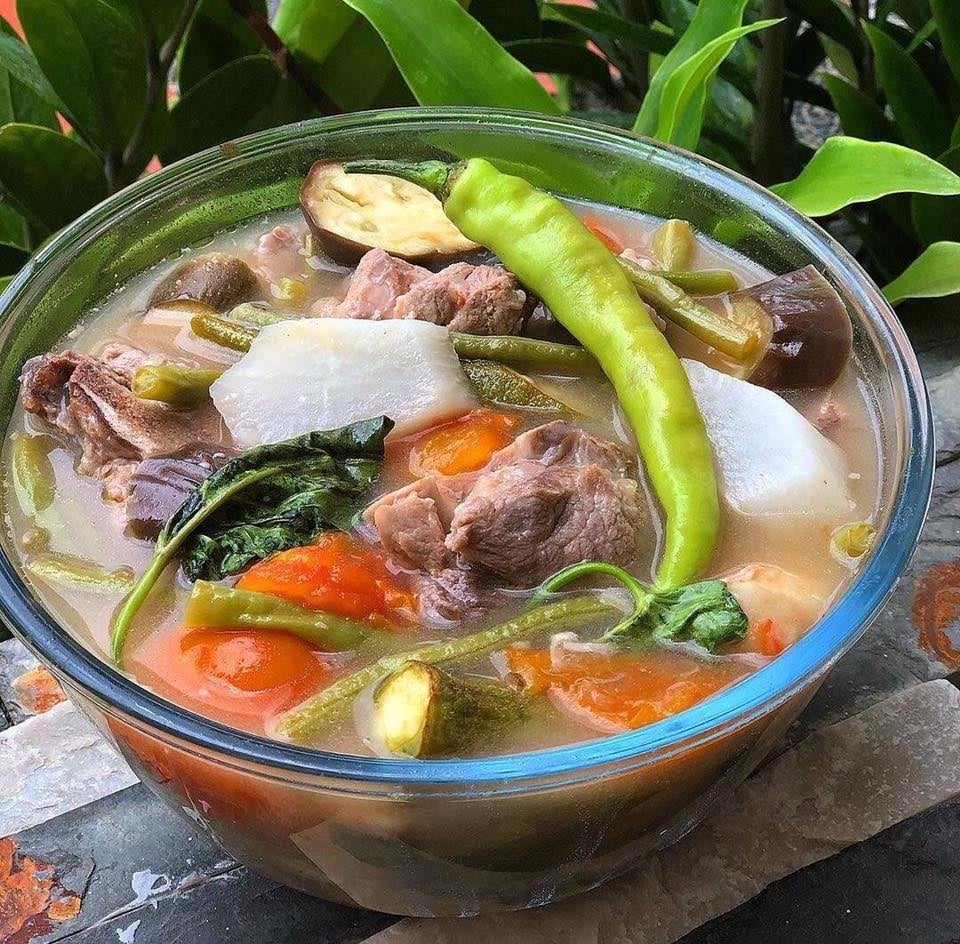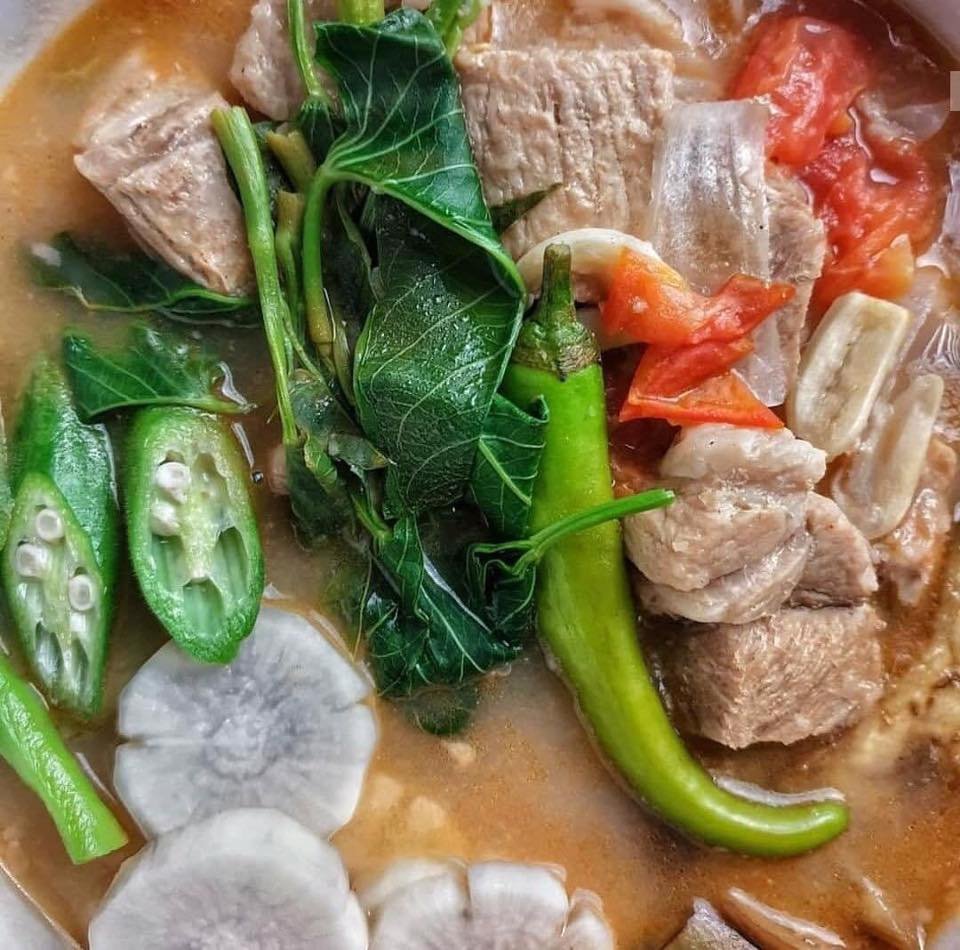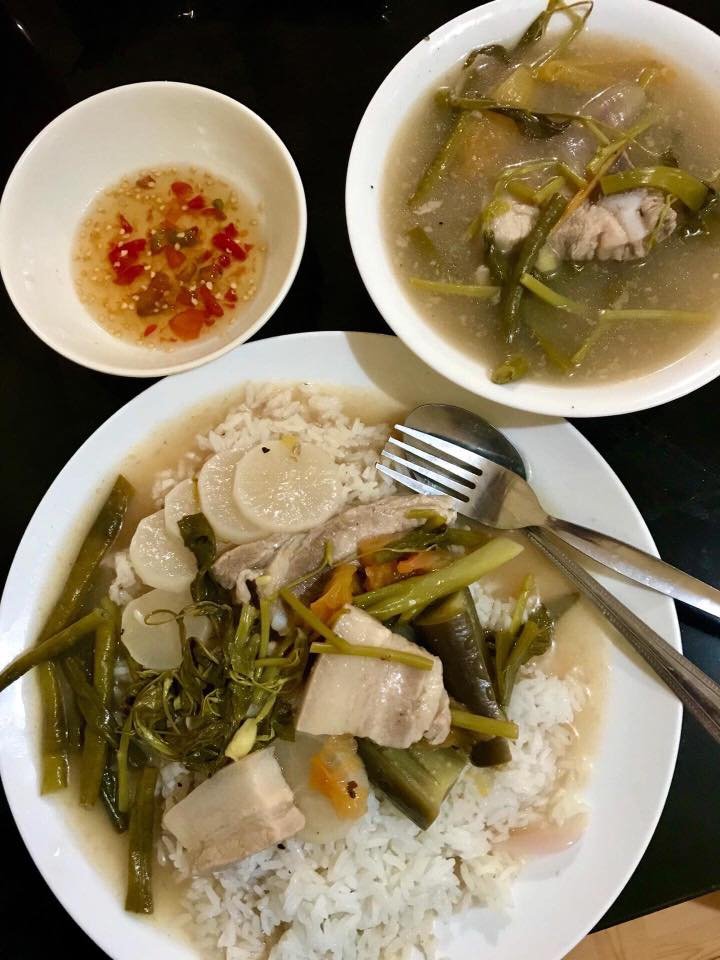Sinigang Na Baboy Recipe



Pork Sinigang recipe is like a superstar in the Filipino food scene, known for its signature sour and savory taste that makes taste buds dance with joy. This dish has been the ultimate comfort food for generations of Filipinos and is practically the Beyoncé of many Filipino households.
Believe it or not, sinigang’s roots go way back to pre-colonial times when ingenious Filipino communities used fruits and plants to whip up sour dishes. It’s like the OG food preservation hack that’s still popular today! Who knew that back then, people were making delicious meals and preserving them all in one go? Talk about efficiency!
So, the next time you savor a hot bowl of sinigang, you’re not only tasting a mouthwatering dish, but you’re also enjoying a piece of Filipino history. It’s like taking a flavorful trip back in time!

What is Sinigang?
Sinigang is a soup dish made with a souring agent, typically tamarind, that gives it its distinct tangy flavor. The soup is often paired with meat, seafood, or vegetables and is typically served with steamed rice. The main ingredients in sinigang include meat (such as pork, beef, or fish), vegetables (such as tomatoes, onions, and leafy greens), and a souring agent (such as tamarind, kamias, or guava). Sinigang recipes can vary depending on the region and personal preference, with some recipes incorporating additional ingredients such as taro or radish.
Variations of Sinigang Recipe
There are several variations of sinigang, each with its own unique taste and ingredients. Here are some of the most popular ones:
- Pork Sinigang – is the most popular type, made with succulent pork meat and bones and accompanied by flavorful vegetables like tomatoes, onions, and spinach.
- Beef Sinigang – is another hearty option, prepared with beef meat and bones and typically paired with veggies such as radish and string beans.
- Fish Sinigang – on the other hand, is a lighter version made with fish and usually served with eggplant and water spinach.
- Shrimp Sinigang – made with shrimp and paired with okra and tomatoes
- Chicken Sinigang – is the mildest version, featuring tender chicken and bok choy and green beans to balance out the flavors.
With so many variations to choose from, there is a sinigang recipe for everyone to enjoy.
Sinigang Mix: What it is and How to Use it
Sinigang mix is a seasoning powder that is used to add flavor and sourness to sinigang. It is a convenient and easy way to make sinigang without having to use fresh tamarind or other souring agents. Sinigang mix typically contains a combination of salt, tamarind, and other flavorings such as garlic, onion, and pepper.
To use sinigang mix, simply add it to the boiling water along with the meat or vegetables. The amount of sinigang mix to use depends on personal preference, but it is typically one to two tablespoons per liter of water. You can adjust the amount of sinigang mix to achieve the desired level of sourness.
While sinigang mix is a convenient option, some people prefer to use fresh tamarind or other souring agents to make sinigang. This allows for more control over the level of sourness and adds a more authentic flavor to the dish.
Health Benefits and Risks of Eating Sinigang
Sinigang can be a healthy dish when made with nutritious ingredients such as lean meat, fish, and vegetables. The souring agent in sinigang, whether it is tamarind or another fruit, is high in vitamin C, which is important for maintaining a healthy immune system.
However, sinigang can also be high in sodium and fat, depending on the type of meat and the amount of seasoning used. This can lead to health risks such as high blood pressure and heart disease. It is important to practice moderation and balance when incorporating sinigang into your diet.
Common Questions about Sinigang
Here are some common questions and answers about sinigang:
- Can I eat sinigang when sick?
- Yes, sinigang can be a good food option when sick because it is easy to digest and can help boost your immune system with its vitamin C content.
- Does sinigang get spoiled?
- Yes, like any other food, sinigang can spoil if left at room temperature for too long. It is best to refrigerate leftovers promptly and consume them within a few days.
- How many days does sinigang last?
- Sinigang can last for up to three to four days in the refrigerator if stored properly in an airtight container.
- What to do if sinigang is too sour?
- If sinigang is too sour, you can add sugar or honey to balance out the sourness. You can also dilute it with more water or add more vegetables or meat to the soup.
- What neutralizes sour taste?
- Bases such as baking soda or milk can neutralize sour taste.
Tips for Making the Perfect Sinigang
Here are some tips for making a delicious sinigang:
- Use fresh and high-quality ingredients for best results.
- Adjust the amount of sinigang mix or souring agent to your desired level of sourness.
- Experiment with different vegetables and meats to find your favorite sinigang recipe.
- Serve with steamed rice and a side of fish sauce or soy sauce for added flavor.
- Store leftovers promptly in the refrigerator to prevent spoilage.
Conclusion
Sinigang is a flavorful and comforting dish that is beloved by Filipinos all over the world. Whether you prefer pork, beef, fish, or shrimp, there is a sinigang recipe for everyone to enjoy. While it is important to practice moderation and balance in consuming sinigang, this dish can be a healthy and nutritious addition to your diet. So next time you’re looking for a tasty and satisfying meal, consider making singang and enjoy its sour and savory flavors. With a few simple ingredients and some basic cooking techniques, you can easily make a delicious sinigang in your own kitchen.
In conclusion, sinigang is a staple dish in Filipino cuisine that has a rich history and a wide variety of recipes. From the original tamarind-based sinigang to the more popular variations using different souring agents, there is no shortage of options for this classic soup. While sinigang mix is a convenient option, using fresh tamarind or other fruits can add a more authentic flavor to the dish. Sinigang can be a healthy and nutritious meal when made with lean meats and vegetables, but it is important to practice moderation and balance. With the tips and answers to common questions provided, you can now make the perfect sinigang in your own home. So gather your ingredients and get ready to enjoy the sour and savory goodness of sinigang!

SINIGANG NA BABOY RECIPE
Ingredients
Method
- Place pork ribs in a large pot. Pour water and bring to a rolling boil over high heat. Use a slotted spoon to skim off the scum that floats to the surface.
- Add the red onion, tomatoes and fish sauce. Once it starts to boil again, cover the pot with the lid and lower the temperature to low. Let it simmer until pork becomes tender.
- Add the taro and cover and simmer again for 5 minutes. (Optional)
- Toss in the string beans and radish and let it cook for 2 minutes
- Add the okra, eggplant, finger chili, and the kangkong stalks.
- Add the tamarind paste and mix until dissolved. Season with salt if needed.
- Before all the vegetables are done, toss in the kangkong leaves. Turn off the heat and let the vegetables finish cooking from the residual heat.
- Serve in bowls with plain steamed rice and fish sauce with some of the finger chili squashed into it as a dip.








